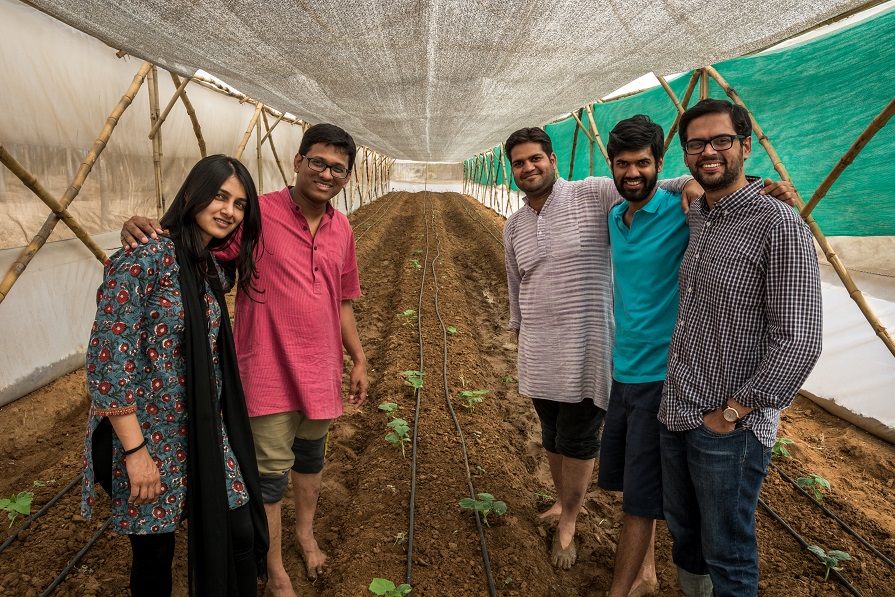Increasing climate resilient incomes for farmers in India
Kheyti designs, adapts and implements low-cost farming solutions that help small farmers increase yield and predictability of produce. They combine these technologies with end-to-end support to give these farmers a seamless path towards income increase. Kheyti has developed a “Greenhouse-in-a-box” – an affordable, modular greenhouse bundled with full stack services that uses 90% less water, grows 7 times more food and gives farmers a steady dependable income.
What is the problem you are seeking to address?
Eighty million small farmers in India LOSE money on average from agriculture. A large reason for this is climate risk, made worse by climate change. The Associated Chambers of Commerce and Industry of India (ASSOCHAM) estimates that Indian farmers lose US$7 billion yearly from pest attacks. A PNAS study found that each degree-Celsius increase in global mean temperature would, on average, reduce global yields of major crops by 3-7.5 per cent. In 2015, news outlets reported that 8-10 million hectares of agriculture had large losses due to few days of unseasonal rains in March. Simply put, farming is becoming an unsustainable profession because of income variability. 75 per cent of farmers (CSDS survey) want to quit farming because of this variability. This is now a universal crisis.

Can you explain your “Greenhouse- in-a-Box” model and the main benefits of this concept?
Kheyti’s mission is to increase climate resilient incomes for smallholder farmers in India. Learning from conversations with thousands of small farmers, we created the Greenhouse-in-a-Box, a low-cost, modular greenhouse bundled with services. Our core product is a greenhouse designed to be modular that covers 1/10th acre and is built at 80 per cent lower cost than conventional greenhouses available in the market. It is covered with insect netting to reduce pest attacks by 90 per cent. It uses shading cloth to reduce temperature five degrees centigrade and drip irrigation to reduce water usage. Overall, it helps farmers grow seven times the yields using 1/50th the water per kilogram when compared to traditional cultivation.
Technology alone is not enough for small farmers because they face risks at every step. This is why we work with partners to offer farmers end-to-end services. We work with banks to offer farmers low-cost loans. We work with input and market companies to provide farmers linkages to the market ecosystem. We provide training and advisory to farmers over the phone and WhatsApp. Our farmers use our end to end solution to earn steady additional incomes of up to US $1,200/year, a 200 per cent increase in farm incomes for most smallholder farmers we work with.

What are the key areas of impact of your business?
- Productivity increase – food and income security
- The greenhouse helps farmers grow 7 times the yields in the same area of land. This helps contribute to the food security and gears us up to serve the increasing world population.
- The increased yields, combined with the high quality crop mix that farmers can grow in a greenhouse, help farmers earn up to $1,200 additional income per year. This is a 200% increase in farm incomes for most smallholder farmers in India.
- Climate resilience – Helping farmers grow through the year and adapt to climate change
- Extreme events – The greenhouse protects crops from extreme climate change events like erratic rains and winds.
- Heat – Its shade-cloth reduces temperatures by 50C and prevents excess heat from disrupting cultivation.
- Pest protection – Insect-netting reduces pests by ~90%
- Climate change mitigation – Easing freshwater systems and reducing pesticide impact
- Water savings – With GIB, farmers require just 1/50th the water/kg when compared to traditional cultivation
- Fertiliser savings – Precision agriculture in the greenhouse uses 40-60% less fertilizers compared to conventional farming.
- Pesticide reduction – The pest netting around the greenhouses reduces pest attacks by 90%. This in turn significantly reduces the usage of pesticides, thereby helping mitigate the ecological damage caused due to over use of pesticides.
What do you need in order to scale up your business? What are your plans over the next few years?
Over the next five years, we want to scale our model to 100,000 farmers across India and create the market for low-cost greenhouses. To achieve this ambitious goal, we are working on solving a few key bottlenecks:
- Greenhouse financing for farmers – While our greenhouse costs 80 per cent less than the market rate and is available in small sizes, smallholder farmers still don’t have access to the capital to purchase the greenhouse upfront and need financing support. However, banks and financial institutions hesitate to lend to farmers and Covid-19 has exacerbated this. Over the years, Kheyti has collaborated with banks and non-bank financial companies to launch pilot programs to design and test greenhouse loan programs for farmers. However, there is a lot more work to be done before this becomes ubiquitous.
- Scalable tech-driven advisory – Advisory support is critical for farmers’ success because greenhouse farming is new to most smallholder farmers. We started out providing advisory to farmers in-person. Over the last couple of years, we have been leveraging technology to provide this advisory to farmers over WhatsApp. To make farmers successful at scale, we need to invest in this “productization” of the training and advisory so that we can deliver this support at scale with high quality and cost efficiency.
- Expanding the team 10x – Our rural and social impact context makes sourcing and retaining talent challenging but also a requirement for success. We need to build a 500+ member team to serve 100,000 farmers over the next five years, and we are working on talent density through organization building measures (culture, feedback systems, L&D) and talent branding (social media, email campaigns).
